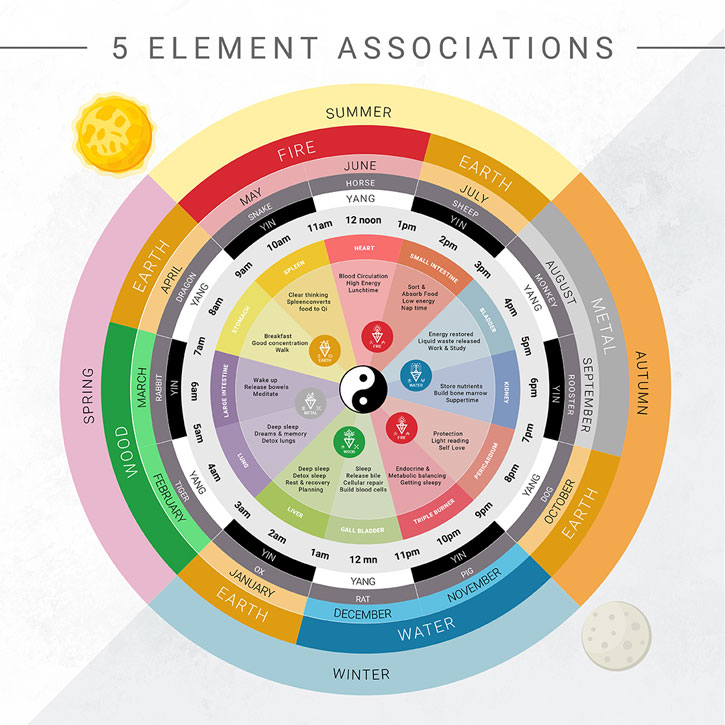
Adjust the earth, fire, wood, water, and metal elements inside and around you to keep your life on the right track.
This year is the year of the Blue Wood Dragon according to the Asian lunar calendar. You may have heard of the animals that make up the Eastern Zodiac, but why wood? Eastern philosophy characterizes the world in terms of five elements: wood, fire, earth, metal, and water. These elements symbolize various aspects of energy. The five stem from two—yin and yang—which come from the one source of all. Five Element Theory recognizes that we’re all part of nature and that the cycles of nature can be found in everything, large and small. Understanding how the elements work can give us a better understanding of the different natural forces that influence our lives inside and out and how, in turn, we can influence them.
Everything can be characterized in terms of one or more of the five elements. Each of our organs are related to a different element, and the date and time of our birth indicate which elements were influential when our bodies first arrived fully formed on the planet. Colors, tastes, emotions, and more have all been associated with different elements.
So What Are the Five Elements?
We can get a sense of each element from how they appear in nature.
Wood: growing and developing, outward movement
Fire: hot and passionately vigorous, ascending, luminous
Earth: embracing and accepting, forming a foundation for new life to sprout, circular movement
Metal: cutting and binding, organizing, attacking and defending
Water: cool, flowing, descending, and mixing
These elements don’t sit around on their own: they interact with each other through natural cycles of expansion and contraction, creation and destruction. They like to be in balance, with one element not being too weak or strong, or too disruptive or controlling. Elemental imbalances lead to imbalances in the body, in our personalities and emotions, and in our environment. Traditional Asian medicine, feng shui, qigong, and similar practices act to correct imbalances so that we can be at our best and have what we want and need.
Important Cycles of the Five Elements
Each of the five elements represents a constant motion from one phase of a cycle to the next. These are the cycles we see throughout nature, including our own life cycle from birth to death, the cycles of the seasons, and the cycle of wakefulness and sleeping. The cycles of the five elements portray the materials, movements, and transformations of the universe. We go from zero or nothingness, then expand (yin-yang, Wood) and rise up (yang-yang, Fire). We remain stable for a while before our energies condense, yielding the fruits of our labor (Earth). Then, we go back down, contracting and moving inward (yang-yin, Metal), and downward until we return to stillness (yin-yin, Water).

Generating Cycle
This cycle of life can be called the Generating/Generation Cycle. It’s a circular cycle in which each element creates one element while being created by another. We can think of it as a mother-child relationship because one element nourishes another element, promoting its growth and development. Together, they produce everything in this world. You can see this relationship is how the elements interact in nature.
The elements create each other by:
Wood burns to create Fire
Fire creates ash/lava (Earth)
From Earth we extract Metal
Metal can be heated to create liquid (Water)
Water poured on seeds grows into plants (Wood)
Because of this cycle, when one element is too weak in our body or our environment, we can boost its “mother” to help nourish that element and bring the system back into equilibrium.
Controlling Cycle
Each of the five elements also provides a check to another element to keep it from getting out of balance. It restrains, controls, or moderates that element, limiting its expression, like in a grandparent to grandchild relationship.
The elements control each other by:
Wood growing through or covering Earth
Earth absorbing or damming Water
Water putting out Fire
Fire melting Metal
Metal cutting Wood
Another way to correct an imbalance in an element lies in this cycle. We can strengthen the elements “grandmother” to get it under control.
Overacting Cycle
The Generating and Controlling cycles are two main cycles of the five elements, but these cycles can also get out of balance. For instance, a grandmother element in the Controlling Cycle can overact and be too controlling, which suppresses the natural growth and expression of the grandchild element.
Counteracting Cycle
On the other hand, a grandchild element can be too willful and rebel against its grandmother element. The grandchild returns the controlling force generated by the grandmother. This goes against the natural order and goes in the opposite direction of the Controlling Cycle. The Counteracting Cycle can also be called the Insulting Cycle.
The elements counteract each other by:
Wood being too hard and breaking the axe cutting it (Metal)
Metal absorbing the heat and putting out a Fire
Fire flaring and drying up Water
Water washing away a shore (Earth)
Earth smothering growing plants (Wood)
Weakening Cycle
The Generating Cycle can also go in reverse so that a child element weakens its mother element. For one element to be produced, another element must be exhausted. This cycle can also be called the Exhaustive Cycle.
The elements exhaust each other by:
Wood takes up and diminishes Water
Water corrodes and weakens Metal.
Metal exhausts Earth when too much is extracted from it
Earth cannot burn and can put out Fire
Fire uses up Wood
How to Balance the Five Elements
Many things can put an element out of balance, such as our lifestyle choices. Childhood trauma can cause long-term imbalances in our overall energetic constitution. Elements are also influenced by the seasons so that if we have a pre-existing imbalance, it may become worse during the seasons associated with that element.
Because all the elements interconnect to form a whole, weakness or excess in any one disrupts their delicate dynamic. An element may stop doing its job of controlling or nourishing the elements around it.
Their balance can be restored by correcting the element that is too strong or weak. This can be done by influencing the element directly or by influencing the elements that nourish or weaken it. Using the Weakening Cycle to diminish an excessive element may be better than using the Controlling Cycle because its effects can be gentler.

Since everything is associated with one or more elements, bringing in or removing foods, colors, emotions, and more from the environment (see chart above) can help restore balance. We can also use body tapping, vibration exercises like these, Brain Wave Vibration, organ sound chanting, energy healing, meditation, and movements such as qigong and yoga to stimulate or calm parts of the body associated with an element we would like to target. Strong or gentle exercise that improves the body’s entire energy system and keeps all the energy flowing lets the body and mind bring themselves back into balance. Seeing a professional such as an acupuncturist or herbalist can also be helpful.
Being aware of and using the five elements of nature is one of the many ways we can be masters of our bodies, masters of our minds, and masters of our environment. Understanding the basics of Five Element Theory can help us do that.
Related Posts
- [Video] The Human Body and the Five Elements
- The Heavenly Code: The Chun Bu Kyung
- The Land Where a New Tao Will Emerge
- Expand Your Mind
- Practice Ilchi Lee’s Earth Qigong for Earth Day for a Deeper Relationship with the Earth


1 Comment. Leave new
Many thanks with gratitude !